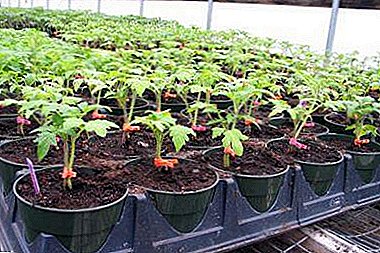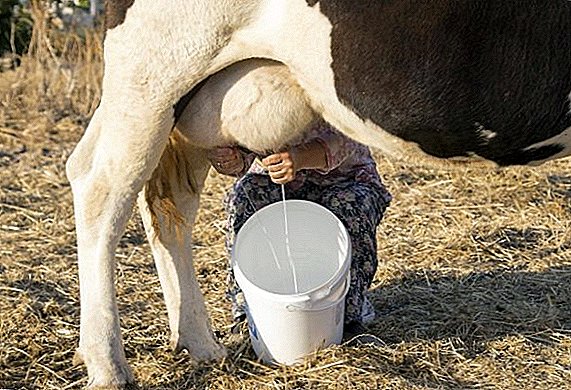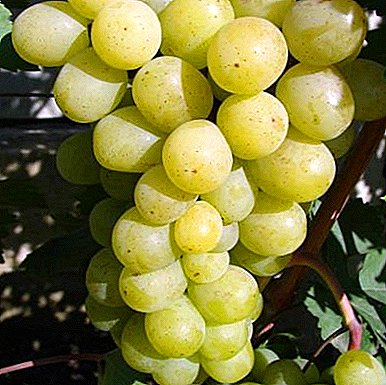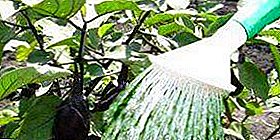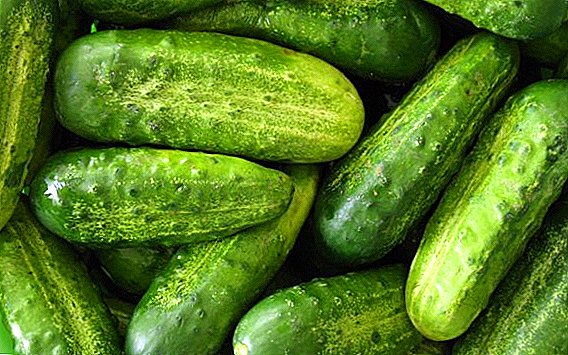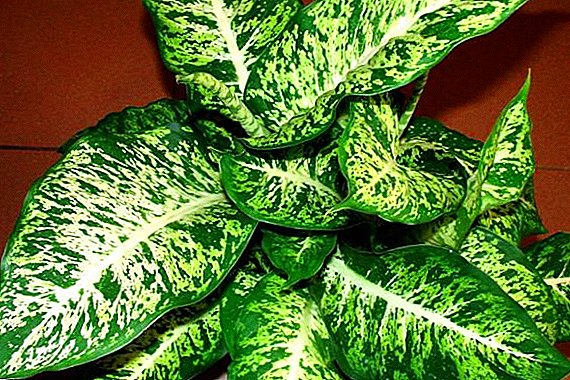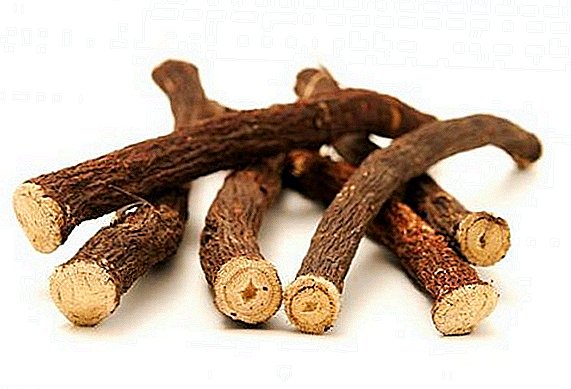 Sunflowers are an integral part of the summer landscape and a popular crop among farmers. In addition to their appearance and seeds, they also have enviable healing properties. And one of the strongest parts of the plant in this regard are the roots. Consider what exactly is their benefit.
Sunflowers are an integral part of the summer landscape and a popular crop among farmers. In addition to their appearance and seeds, they also have enviable healing properties. And one of the strongest parts of the plant in this regard are the roots. Consider what exactly is their benefit.
Botanical description
The biological genus Sunflower combines a huge number of species but in our area the most massive is the annual sunflower.

The core rhizomes of these plants grow into the soil by 2-3 m, and thus the plant is fed by moisture from the deep layers.
Learn what the sunflower seeds bring to the body.
Everyone is familiar with a tall (up to 5 m) straight stem with a soft core, studded with stiff hairs. The leaves are placed on long petioles, have an oval-heart-shaped form with a point at the edges. Their plate reaches 35-40 cm in length.
On large "baskets" surrounded by wrapping leaves, large (up to 50 cm in diameter) flowers from yellow-cream to orange color are visible. During the period of ripening and flowering, they follow the sun, as it were, turning after it, but with time they become fixed in one position.

It is time to bloom in July-August and usually lasts 25-30 days.
Important! For therapeutic purposes, parts of a plant grown on a field with a minimum amount of nitrogen fertilizing are taken (their overabundance stimulates the growth of green mass, but inhibits the development of the root).
Pollination - cross (that is, with the help of bees and other insects). Fruits in the form of leathery lightly cut seeds are harvested in September. According to their appearance, they determine the type of use: white or gray striped are considered to be gryzny, and dark gray, with less expressive stripes, are oleaginous.
Chemical composition
Sunflower roots are rich in valuable substances. What is only one list of vitamins and other valuable compounds, among which are present:

- tannins (11.2-11.5% of the total mass);
- polysaccharides, they are also slow carbohydrates (10.3%);
- inulin in the proportion of 5.5-6.2%;
- valuable hemicellulose compounds of types A and B (5.13% and 1.6%, respectively);
- pectins - 2.5%
- vitamin C;
- B vitamins with indices from 6 to 11;
- vitamins A, D and K;
- about 0.8% water soluble polysaccharides;
- essential amino acids, among which are arginine and leucine.

- calcium;
- potassium;
- magnesium;
- phosphorus;
- manganese;
- iron;
- barium;
- silicon.
Use in traditional medicine
An impressive set of valuable substances is widely used for the preparation of folk remedies. Such formulations are used for the following purposes:

- body cleansing and metabolism regulation;
- crushing kidney stones and removing urates from the bladder;
- treatment of arthritis, arthrosis and osteochondrosis;
- cleaning vessels from cholesterol clusters;
- blood pressure control;
- prevention and removal of pain in the heart;
- relief from severe headache;
- fight against cystitis.
Normalization of blood pressure also contribute to: cantaloupe melon, champignons, plum, gooseberry, chervil, basil, honey, beet leaves, cherry, mint, celandine.
Such a wide range of application of ordinary-looking roots to some is surprising. Although there is nothing surprising here - this part of the sunflower has long been famous for its healing properties that deserve a separate description.
Did you know? Archaeologists say that they started growing sunflower 5 thousand years ago (in the territory of the modern states of Arizona and New Mexico).
Medicinal properties
As a pharmacological component, these roots have a tonic and tonic, immunomodulatory and antipyretic effect. In addition, they are also a powerful natural adsorbent, as well as a diuretic.
The therapeutic effect of rhizomes is manifested in:

- strengthening the walls of blood vessels and heart muscle;
- immunity support;
- hypotonic action - the increased pressure decreases (both upper and lower);
- excretion of excess cholesterol;
- restoration of the normal operation of the esophagus (especially with constipation);
- soft cleaning of the liver, which allows for normal functioning of both it and the urinary canals;
- splitting and removal of deposits of slags and salts of heavy metals;
- rapid removal of edema and neutralization of inflammation;
- cleaning the cartilage tissue from salt and preventing its new accumulations.
Important! Accepting roots for therapeutic purposes requires an accurate diagnosis. They are able to dissolve stones of "acidic" origin (urate and oxalate), but, alas, they are powerless against alkaline formations (phosphate and carbonate stones).
As you can see, there is indeed a lot of benefit. But then the question arises - how to get powerful self-made medicine from such valuable raw materials.

There are a huge number of recipes, but pay attention to only a few. They are easy to prepare, but no less effective.
Also, immunity has a positive effect: safflower, horseradish, garlic, apples, ramson, fir, black walnut, aloe, almonds, viburnum, cornel, Chinese lemongrass, lemon balm.
Infusion
The simplest infusion will help to correct the blood sugar level in diabetes. Dried hairs, which were set aside from the central rhizome (taken during flowering), are taken as a blank.

Processing looks like this:
- 1 tbsp. l raw materials poured boiling water (2 liters).
- Then the container is covered with a lid and wrapped tightly for 45-50 minutes.
- The finished liquid can not decant, and drink immediately, in several approaches per day (one-time volume does not matter).
Tincture
It is used very carefully: the substances contained in the roots, interacting with alcohol, give a very strong effect. This tool is used mainly for severe colds or ARVI (to bring the temperature down).
Did you know? Once in Europe in the XVI century, the sunflower was first grown as a purely decorative species. And only in 1716 in England a patent was issued for the extraction of oil - from that moment the culture became agricultural.
The algorithm for obtaining is very simple:
- 50 g of small raw materials are filled in with 0.5 l of vodka. The container is covered with a lid and placed in a cool dark place for 7-10 days.
- Periodically shake the mixture.
- After this time, everything is decanted, the tincture is ready.

Reception: 3 times a day, 1 tbsp. l 20-30 minutes before a meal (preferably slightly diluted with water).
Other plants also have medicinal properties, such as lungwort, laconosa, savory, white silverweed, marsh wild rosemary, peppermint, anise, and cholstyanka.
Decoction
Broths are traditionally considered to be one of the strongest compositions. So, with the participation of sunflower roots such a tool will help remove sand and small stones from the kidneys (as well as salt from the joints). To obtain it you will need:
- Pour 1 cup of crushed collection of 3 liters of water.
- After that, the container is put on a small fire, brought to a boil and boil for 5 minutes.
- Then the liquid is decanted and cooled. You can store a closed container in the refrigerator. The important point is that after decanting the slurry is not thrown away, but retained for re-treatment. The second time it will have to boil for 10 minutes, and the third - 15.
- The intake rate is 1 l per day (time and number of approaches per day do not matter). Long breaks are surely made: for a 2-month course of treatment, you need to drink no more than 7 liters.
Video: sunflower root, how to make a decoction.
Joint pains will subside, and the tumors will go away if a compress is applied on the basis of another decoction:
- The same glass of crushed root is filled in 1 liter of water.
- Boil you need for an hour.
- The result will be about 0.5-0.6 l of a saturated and strong liquid, in which four folded cloth is moistened.
- It remains to attach it overnight to the diseased area, cover with polyethylene and cotton, not forgetting to tie a woolen scarf.
Important! During the reception, be sure to drink plenty of purified water. It would be good to include vegetables in the menu, while forgetting about alcohol in any form (for the period of treatment, even beer is banned).
After 4-5 procedures, the pain will disappear. Be prepared for the fact that at first there will be a burning sensation, which will eventually subside. And, of course, such a liquid can not be drunk - this is a purely external means.

Contraindications
From taking any medication based on sunflower rhizomes is definitely worth refusing:
- if you are hypersensitive or allergic to raw materials;
- during pregnancy and breastfeeding;
- if the diagnosis revealed insoluble kidney stones.
Read also, how during pregnancy to use honeysuckle, turnip, bee pollen, Peking cabbage, nectarine, blackberry, walnuts, lettuce, dates
These include increased pressure, a burning sensation in the chest and joints, or dehydration. Faced with these symptoms, immediately stop taking. Seeing a doctor also does not hurt (although it is desirable to agree on a course of treatment even before use).

Harvesting and storage of raw materials
To make such reserves is not a problem, the benefit in our area is such raw materials in abundance. True, you need to know the basic nuances of processing and further storage.
Did you know? The ancient Incas revered sunflower as a ritual plant.
Work is started when the sunflower has reached full maturity (the seed coat has become brown and finally hardened). The scheme of the collection, carried out immediately after the harvest and cutting the head, looks like this:

- rhizomes digging ordinary shovel;
- the soil is immediately shaken off (it is impossible to wash the raw materials intended for drying) and cut off the stem from the stem with a sharp knife or ax;
- from the central root cut side "strings". The main rhizome is cut lengthwise, into 4-6 parts (each one in diameter will be approximately like a pencil);
- the workpiece is laid out in a shaded place (ideally under a canopy). The presence of a draft is necessary. Accelerate the drying process is not advised: hitting the sun or in the oven, the raw material is rapidly losing useful components.
After making sure that the harvest is dry, the roots are crushed into a fraction of 1.5 cm. Usually they break up without much effort, but keep a knife nearby just in case.

The blank is stored in cardboard boxes or cloth bags, in cool dark places. (attic, come down and dry basement without rodents). Shelf life - 1 year for crushed parts and 3 years for whole rhizome.
Important! Stocks are periodically inspected for mold and other damage. Wicked particles are discarded immediately.
Those who buy sunflower roots should pay attention to their appearance. This dense part of the plant has a dark color, and inside a small tubule is visible. To check, clean the peel a little - if it looks white, you can take it.

Sellers sometimes do not say in what conditions the sunflower grew and what they cultivated the field with. To check whether the root is ready for medical use, one copy of the entire batch is filled with boiling water and allowed to infuse for 10-20 minutes. Quality infusion can be seen on the light brown tone and delicate aroma of sunflower oil.
Country owners can grow a “sunny flower” in their garden. Check out the plant varieties and learn how to protect it from diseases and pests.
These are the beneficial properties of the sunflower root and how it is used in traditional medicine. We hope that this data will be useful to our readers, and they will reasonably approach the use of such tools. Good health to all!
Reviews from the network





